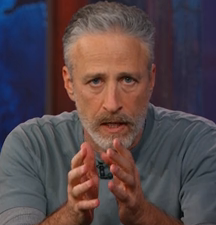When Jon Stewart left Comedy Central’s The Daily Show with Jon Stewart, people were wondering what he was going to do. The answer is simple: He is doing good. Listen up, professionals, and learn from Stewart, who is using his positioning power to give others a voice.
On the December 7, 2015 Daily Show, host Trevor Noah welcomed back Stewart, who is bravely tackling a serious issue before Congress right now: the fight to continue funding for first responders of the 9/11 tragedy through the James Zadroga Health and Compensation Reauthorization Act. H.R. 1786 “amends the Public Health Service Act to extend the World Trade Center (WTC) Health Program Fund. Watch the full episode here.
Stewart and a video crew accompanied first responders to Capitol Hill, visiting the offices of senators, most of whom were (conveniently) out, unavailable or in meetings. With every rejection from Senate staff, Stewart pushed on, heading to the next senator’s office, determined to let first responders’ voices be heard. There were no altercations, no harsh words, just a message that needed to be heard. The only leader who took the time to talk with Stewart and first responders was Senator Rob Portman (R-OH), who later signed the act.
For two decades, I have coached professionals on the importance of power positioning. I define power positioning as “The art of putting yourself in a place that you want to be, that maximizes your talents, skills and contacts.” Stewart demonstrated power positioning in action on Capitol Hill. In his Daily Show appearance, he reached millions of loyal Daily Show viewers, encouraging them to contact their senators and Senate Majority Leader Mitch McConnell (R-KY). He asked them to Tweet using #worstresponders. He recognized that he had the clout and power to raise his voice and raise the collective consciousness of Americans. Political leaders across the country can take pointers from Jon Stewart’s integrity and high level of professionalism. It comes at a time when lives have been shattered and communities are still rebuilding from devastation. It’s time to do the right thing.
All too often, you can easily become passive, detached or uninvolved in the issues of your community, your workplace and the world. The next time you rationalize why you shouldn’t get involved, think again. Your voice could make a difference in someone else’s quality of life.
Thank you, Jon Stewart, for elevating our awareness about this important issue. You continue to be a positive role model for other leaders. You inspire and motivate us all to do a better job of putting other people’s needs ahead of our own.










